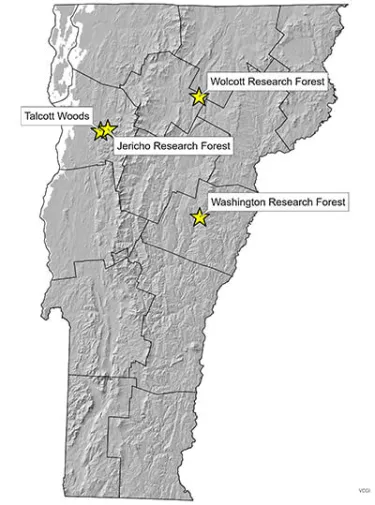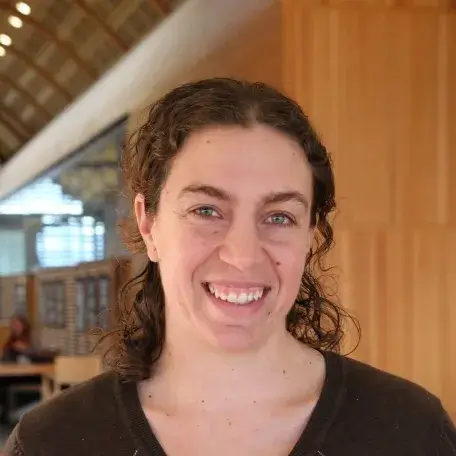Forests
The UVM Forests encompass four landholdings: two in the Champlain Valley of Vermont, one in the central part of the state, and one in northern Vermont.

Learn more about each forest
Teaching
Many students visit the Research Forests while at UVM. Nearly 20 courses from the Rubenstein School and across UVM use the Forests for instruction on topics as diverse as dendrology, forest management, silviculture, wildlife management, snow hydrology, and historic preservation.
The Research Forests are an important component of these course curricula. As many as 200–300 students learn at the Forests each semester as they complete coursework and often gather data for class projects. About 20–30 students per semester participate in activities at the Forests as part of internships, clubs, and student-planned events.
Public Use
The Research Forests are open to the public for non-motorized recreation, including hunting (with the exception of Talcott Woods where hunting is not permitted). Please contact us with any questions about use, and view our hunting guidelines.
Research
The UVM Forests have a long legacy of research, beginning with studies of farmland restoration and exotic conifer growth and survival in the 1940s to current projects focused on climate change adaptation and old forest restoration strategies. The Forests offer research opportunities across a broad range of disciplines including forest ecology and management, wildlife habitat and ecology, water resources, and ecosystem processes.
Research access is available to UVM students, faculty, and affiliates, as well as researchers from outside organizations. If you are interested in beginning a project at the UVM Research Forests, please contact Jessica.Wikle@uvm.edu.
Past Research at the UVM Forests
- Clark, Peter W., and Anthony W. D’Amato. 2023. Seedbed Not Rescue Effect Buffer the Role of Extreme Precipitation on Temperate Forest Regeneration. Ecology 104 (3): e3926.
- Clark, Peter W., and Anthony W. D’Amato. 2021. Long-Term Development of Transition Hardwood and Pinus strobus - Quercus Mixedwood Forests with Implications for Future Adaptation and Mitigation Potential. Forest Ecology and Management 501 (December): 119654.
- Clark, Peter W., Anthony W. D’Amato, Kevin S. Evans, Paul G. Schaberg, and Christopher W. Woodall. 2021. Ecological Memory and Regional Context Influence Performance of Adaptation Plantings in Northeastern US Temperate Forests. Journal of Applied Ecology, October.
- Ross, Donald S., Meghan E. Knowles, Juliette I. Juillerat, Josef H. Görres, Charles V. Cogbill, Sandy Wilmot, and Kristen D’Agati. 2021. Interaction of Land Use History, Earthworms, Soil Chemistry and Tree Species on Soil Carbon Distribution in Managed Forests in Vermont, USA. Forest Ecology and Management 489 (June): 119049.
- Coleman, Kimberly J., Elizabeth E. Perry, Dominik Thom, Tatiana M. Gladkikh, William S. Keeton, Peter W. Clark, Ralph E. Tursini, and Kimberly F. Wallin. 2020. The Woods around the Ivory Tower: A Systematic Review Examining the Value and Relevance of School Forests in the United States.
- Switzer, Kristen. 2018. Relationships between Climate and Growth of Quercus rubra, Pinus strobus, and Tsuga canadensis in Northern Vermont. UVM Honors College Senior Theses, January.
- Meigs, Garrett W., and William S. Keeton. 2018. Intermediate-Severity Wind Disturbance in Mature Temperate Forests: Legacy Structure, Carbon Storage, and Stand Dynamics. Ecological Applications 28 (3): 798–815.
- Gottesman, Aviva J., and William S. Keeton. 2017. Regeneration Responses to Management for Old-Growth Characteristics in Northern Hardwood-Conifer Forests. Forests 8 (2): 45.
- Ford, Sarah E., and William S. Keeton. 2017. Enhanced Carbon Storage through Management for Old-Growth Characteristics in Northern Hardwood-Conifer Forests. Ecosphere 8 (4): e01721.
- Dove, Nicholas C., and William S. Keeton. 2015. Structural Complexity Enhancement Increases Fungal Species Richness in Northern Hardwood Forests. Fungal Ecology 13 (February): 181–92.
- Juillerat, Juliette I., Donald S. Ross, and Michael S. Bank. 2012. Mercury in Litterfall and Upper Soil Horizons in Forested Ecosystems in Vermont, USA. Environmental Toxicology and Chemistry 31 (8): 1720–29.
- Hart, Edmund M., and Nicholas J. Gotelli. 2011. The Effects of Climate Change on Density-Dependent Population Dynamics of Aquatic Invertebrates. Oikos 120 (8): 1227–34.
- Smith, Kimberly J., William S. Keeton, Mark J. Twery, and Donald R. Tobi. 2008. Understory Plant Responses to Uneven-Aged Forestry Alternatives in Northern Hardwood–Conifer Forests. Canadian Journal of Forest Research 38 (6): 1303–18.
- Halik, Shari, and Dale R. Bergdahl. 2006. Observations on the Natural History, Development, Range, and Future of Eubulus parochus (Herbst) (Coleoptera: Curculionidae). The Coleopterists Bulletin 60 (4): 325–32.
- Keeton, William S. 2006. Managing for Late-Successional/Old-Growth Characteristics in Northern Hardwood-Conifer Forests. Forest Ecology and Management 235 (1): 129–42.
- McKenny, Heather C., William S. Keeton, and Therese M. Donovan. 2006. Effects of Structural Complexity Enhancement on Eastern Red-Backed Salamander (Plethodon cinereus) Populations in Northern Hardwood Forests. Forest Ecology and Management 230 (1): 186–96.
- Nijensohn, Samuel E, Paul G Schaberg, Gary J Hawley, and Donald H DeHayes. 2005. Genetic Subpopulation Structuring and Its Implications in a Mature Eastern White Pine Stand. Canadian Journal of Forest Research 35 (5): 1041–52.
- Beard, Karen H., Deane Wang, Carl E. Waite, Kelly L. M. Decker, Gary J. Hawley, Donald D. DeHayes, Jeffery W. Hughes, and Jonathan R. Cumming. 2005. Quantifying Ecosystem Controls and Their Contextual Interactions on Nutrient Export from Developing Forest Mesocosms. Ecosystems 8 (2): 210–24.
- Stewart, J. E., S. Halik, and D. R. Bergdahl. 2004. Viability of Sirococcus clavigignenti-juglandacearum Conidia on Exoskeletons of Three Coleopteran Species. Plant Disease 88 (10): 1085–91.
- Halik, S., and D. R. Bergdahl. 2002. Potential Beetle Vectors of Sirococcus clavigignenti-juglandacearum on Butternut. Plant Disease 86 (5): 521–27.
- Hannah, Peter R. 1999. Species Composition and Dynamics in Two Hardwood Stands in Vermont: A Disturbance History. Forest Ecology and Management 120 (1): 105–16.
- Hannah, Peter R. 1998. Observations on Planted Yellow Birch. Northern Journal of Applied Forestry 15 (2): 106.
- Sendak, Paul E., James R. Bove, Dale R. Bergdahl, Donald R. Tobi, and Neil K. Huyler. 1997. Effects of Eutypella Canker and Sugar Maple Borer on Merchantable Volume Loss in Sugar Maple. Northern Journal of Applied Forestry 14 (1): 26–31.
- Halik, S., and D. R. Bergdahl. 1994. Long-Term Survival of Bursaphelenchus xylophilus in Living Pinus sylvestris in an Established Plantation. European Journal of Forest Pathology 24 (6–7): 357–63.
- Halik, S., and D. R. Bergdahl. 1992. Survival and Infectivity of Bursaphelenchus xylophilus in Wood Chip-Soil Mixtures. Journal of Nematology 24 (4): 495–503.
- Halik, S., and D. R. Bergdahl. 1990. Development of Bursaphelenchus xylophilus Populations in Wood Chips with Different Moisture Contents. Journal of Nematology 22 (1): 113–18.
- Hannah, P. R. 1990. Survival and Growth of Yellow Birch Rooted Cuttings on a Forest Site in Vermont. Northern Journal of Applied Forestry 7 (2): 94–95.
- Mazzola, M., and D. R. Bergdahl. 1989. The Phenology and Spore Dissemination Patterns of Uredinopsis mirabilis on Abies balsamea and Onoclea sensibilis. Canadian Journal of Forest Research 19 (1): 88–95.
- Hannah, Peter R. 1987. Early Growth of Planted Yellow and Paper Birch and European Birches in Vermont. New Forests 1 (4): 343–49.
- Hannah, Peter R. 1985. Response of Yellow Birch and Sugar Maple to Release and Fertilizer. Northern Journal of Applied Forestry 2 (4): 108–10.
- Bergdahl, D. R., and M. Mazzola. 1985. Some Relationships between Uredinopsis mirabilis, Paradiplosis tumifex, and Dasineura balsamicola in the Needles of Abies balsamea. Canadian Journal of Forest Research 15 (3): 551–54.
- Hawley, Gary J., and Donald H. DeHayes. 1985. Hybridization Among Several North American Firs. I. Crossability. Canadian Journal of Forest Research 15 (1): 42–49.
- DeHayes, Donald H. 1981. Genetic Variation in Susceptibility of Abies balsamea to Mindarus abietinus. Canadian Journal of Forest Research 11 (1): 30–35.
- Dehayes, Donald H., Donald I. Dickmann, and Walter A. Lemmien. 1980. Management of Exotic Timber Trees in Temperate Regions of Eastern North America: An Assessment. Forest Ecology and Management 3 (January): 31–44.
- Hannah, P.R. 1974. Thinning Yellow Birch Saplings to Increase Main Leader Growth. Research Paper MP 80. Vermont Agricultural Experiment Station.
- Adams, William R., and Galen O. Hutchinson. 1961. Total and Merchantable Volume Growth of Japanese Larch. 620. Burlington, VT: University of Vermont.
- Adams, William R. 1955. A Control for Pine Leaf Aphid. 582. Bulletin: Vermont Agricultural Experiment Station. Burlington, VT: University of Vermont.
- Adams, William R., and F.W. Taylor. 1955. Charcoal Markets in Vermont. 582. Bulletin: Vermont Agricultural Experiment Station. Burlington, VT: University of Vermont.
- Adams, William R., and G.L. Chapman. 1942. Competition in Some Coniferous Plantations. 489. Bulletin: Vermont Agricultural Experiment Station. Burlington, VT: University of Vermont.
- Adams, William R., and M.R. Schneller. 1939. Some Physiological Responses to Close Pruning of Northern White Pine. 444. Bulletin: Vermont Agricultural Experiment Station. Burlington, VT: University of Vermont.
